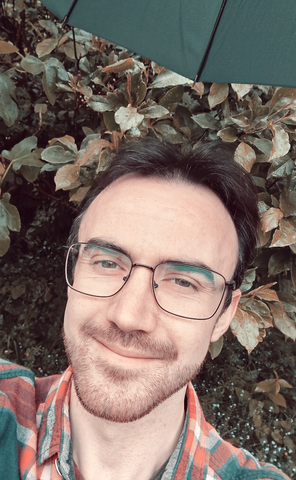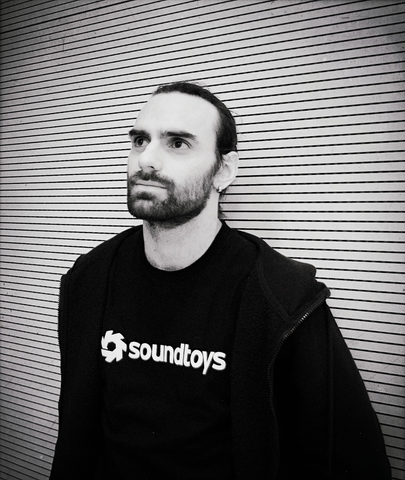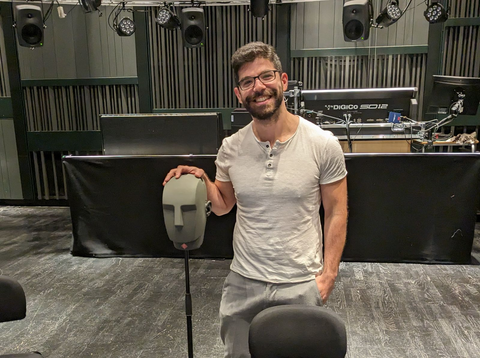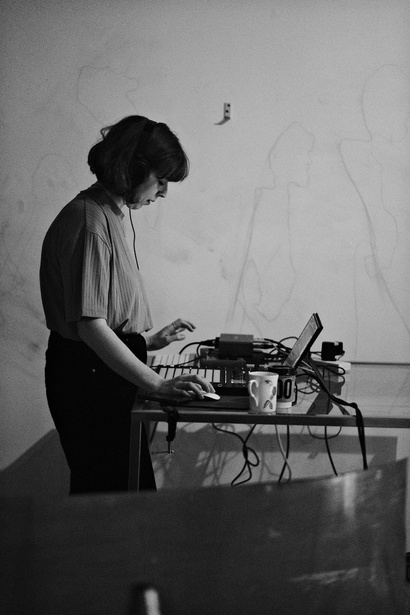Spatial
audio gathering
Practice as Research Methodologies
Case studies of spatial music
Audio Visual
Installation
Future ideas on spatial audio and spatialisation techniques or technologies
Methods for spatial analysis
Philosophical takes on spatialisation and space as a metaphor
Spatial audio AV works
Gaming
Immersive Audio in Performance
Musicology
Live Coding
Sound and Environment
17-18 JUNE 2024
Sustainability in Immersive Tech
VR/AR
Acoustic Ecology
Personal experiences with spatialisation techniques and technologies
PACE Building, De Montfort University
7BQ, Richmond St, Leicester
LE2 7GZ
Interactive
Acousmatic Composition


Music Techology
Composition
Moving from technique to technology in spatialisation


Computer Programming for Video games and Architecture
Spatial audio in performances and sound art
Key note Speakers
17-18
JUNE
2024
We are delighted to announce the following keynotes who will deliver special sessions at the symposium. Information about their sessions can be found below.
Annie Mahtani
Spatial Narratives: Creative Approaches to New Technologies
In the rapidly evolving landscape of spatial audio, new tools for composing, recording, and performance are transforming how we create and experience spatial audio works. This presentation delves into the composer’s own methodologies and creative processes as they explore these technologies, including tools for ambisonics composition, higher-order ambisonics field recording, and live performance with the IKO loudspeaker.
Through practical examples and live demonstrations, attendees will gain valuable insights into these tools and strategies used to sculpt spatial narratives within musical works.
Annie Mahtani (UK, 1981) is an electroacoustic composer, sound artist and performer working and living in Birmingham (UK). She studied with Jonty Harrison at master’s and doctoral level at the University of Birmingham, completing her PhD in 2008.
Her output encompasses electronic music composition from acousmatic music to free improvisation. As a collaborator, Annie Mahtani has worked extensively with dance and theatre, and on site-specific installations. With a strong interest in field recording, her work often explores the inherent sonic nature and identity of environmental sound, amplifying sonic characteristics that are not normally audible to the naked ear. Her music explores abstract and recognizable sound worlds and all the spaces in between. Annie works extensively with multichannel audio both in fixed medium works and in live performance.
Spatial audio explorations with the IKO Loudspeaker
This talk will discuss new spatial audio technologies such as the IKO loudspeaker. Throughout this talk I will provide examples of how composers and sound artists are using this loudspeaker to create works in response to the acoustics and materiality of a variety of different and unique spaces. This talk will also feature a demo of the IKO Loudspeaker.
Dr Brona Martin is an Electroacoustic composer and sound artist from Banagher, Co. Offaly, Ireland. Her compositions explore narrative in Electroacoustic music, acoustic ecology and spatialisation techniques through the creation of metaphorical and real-world representations of soundscapes where the aim is to reveal particular sonic characters that are not normally the focus of listening.
www.gre.ac.uk/people/rep/las/brona-martin
Spatialization, A Critical Overview
Spatialization as both a technique and a technology has been used in the arts and media for many decades. There are a number of technologies to help us achieve the sensations of three dimensional audio, and a broad range of techniques with which precise audio spatialization can be achieved. Yet, in my experice, the results are often quite unsatisfying.With a large array of speakers the sensation can still be impressive, but may lack the dynamics of world spatiality. It
also comes with great political implications and may be seen as an excluding construction for rendering electroacoustic music; its potential social dominance should be considered.
Although there is a great amount of knowledge in the commercial media industry of how to create a sonic space, but in terms of resources the multimedia industry has won the battle here. Not even academia can compete in terms of technology development. In the practice of field recordings there is a slightly different, but equally impressive knowledge about how to record and portray spatial sound. In my own work, however, I have felt a growing frustration
that is connected to my inability to use the methods of these and other practices and apply them to my compositionalpractice. Is there a knowledge gap somewhere in the continuity between accuracy, reproduction, meaning and spatialgestalt in sound art? To approach this frustration I have worked together with my colleague Jan Schacher for a few years in trying to better
understand what spatial listening may constitute. By engaging ourselves, students, and fellow artists in what may be best described as deep spatial listening exercises. Through these we have tried to expand our spatial sensibility, on the one hand, and our ability to conceptualize it on the other. Going on listening excursions and discussing our experienceswe have documented the results in various ways, employing qualitative and experimental methods on the results.
A brief summary of our experiences is that the basic method of listening excursions is effective at large and the firstgeneral chat (on site) about what was heard is also quite effective. However, which should come as no surprise, the phase is much more difficult.
Henrik is an active performer (saxophones and electronics) of improvised and contemporary music and a composer of acoustic and electroacoustic music. He is professor at the Royal College of Music in Stockholm at the department for electroacoustic music composition, and his research is concerned with improvisation, interactivity, spatialisation and experimental electroacoustic music.
The Material Agency of Acoustic Space
Nikos is a composer of predominantly acousmatic and mixed music. He read music at the University of Wales (Bangor, Wales, UK), where he studied composition with Andrew Lewis and completed a doctorate at the University of Sheffield (England, UK) under the supervision of Adrian Moore.
Imagining Space and Place Through Sound and Music
This paper picks up from my contributions to the Oxford Handbook of Sound and Imagination (2019) – ‘Playing the Inner Ear – Performing the Imagination’ - and to MuSA 2023 (Manchester) - ‘Imagination and Image (in sonic art)’. In these I suggested that the imagination was the most powerful tool for sound synthesis that we possess. But what of space, movement and, most importantly, listener perspective? How do we imagine these? How do we describe and represent them (‘write them down’)? On the one hand we have geometric and distanced worldviews of space and on the other, participatory and immersive representations of place which we might also describe as environmental or ecological. (I shall critique this distinction.) I present two case studies from my own work. Solo Flute Quartet (2017-18), for a solo performer on four flutes, with live electronics. This attempts to create a surround soundworld of multiphonic timbral material such that the listener is suspended in an ever changing web of flute sound. The soloist and listener remain stationary while the sound is continuously in motion. I describe Near and Far (at Once) - which will be performed at one of the concerts during the symposium - as an imaginary soundwalk, a multichannel acousmatic work which ‘walks us’ from the wind farm off Brighton’s coast, onto the beach, through the pier, the city, via loud and quiet places - real or imaginary - on up to the top of the Downs on a hot day. Here the opposite is the case – the imaginary listener is in constant motion across the dynamic landscape. A link between the sounds and scenes is the ‘murmuration’ of birds, humans, vehicles, insects, trees, atmospheres. The silent movie of a starling murmuration is (for me) already sounding. These are profoundly spatial – how might this be captured or synthesised, and how best presented to the listener? [SE]
Simon is an electroacoustic music composer working mostly with live electronics. He studied Natural Sciences and Music Education at Cambridge (1968-72) where he first encountered electronic music. During a PhD at City University London in the 1970s, he founded the studio there and was its director until 2004 when he moved to De Montfort University.
programme
Monday 17th June

17-18
JUNE
2024
9:30 - 10:00 Registration and Welcome -PACE STUDIO 1
Coffee and Tea available
10:00 - 11:00 Keynote Presentation - PACE STUDIO 1
Henrik Frisk
Spatialization, A Critical Overview
11:00 - 11:15 Break
11:15 - 12:15 Paper Session - PACE STUDIO 1
Neval Tarim
Compositional strategies to create experiences of imaginary spaces through headphone listening
***
George Edmondson
Sound Imaging: Exploring Sonic Ethnography in Northfield, Birmingham
***
Robert Chafer
Spatial Audio in Mixed Reality
12:15 - 13:30 Lunch Break
13:30 - 13:45 Performance - PACE STUDIO 1
Tim Cooper and Lucia Capellaro
Labyrinth (14:18)
13:45 - 14:45 Keynote Presentation - PACE STUDIO 1
Simon Emmerson
Imagining Space and Place through Sound and Music
14:45 - 15:15 Acousmatic Concert - PACE STUDIO 1
Neval Tarim
SPATIO (07:16)
***
George Edmondson
Loss (9:52)
***
Andrew Lewis
Cori Spezzati (11:05)
15:15 - 15:30 Break
15:30 - 16:30 Keynote Presentation - PACE STUDIO 1
Nikos Stavropolous
The Material Agency of Acoustic Space
16:30 - 16:45 Break
16:45 - 17:30 Acousmatic Concert - PACE STUDIO 1
Enrico Francioni
Simple_test (9:59)
***
David Nguyen
Textures Arc ‘The Points’ (9:56)
***
Tim Land
Pembrokeshire Coastal (6:42)
***
Break
***
Leo Cicala
Macropsia (7:53)
***-
Jake Parry
The Grain of the Voice (7:02)
17:30 - 19:00 Dinner Break
19:00 - 20:30 Evening Concert - PACE STUDIO 1
Henrik Frisk
For Bill, Rising (10:00)
***
Simon Emmerson
Near and Far (At Once) (12:00)
***
Nikos Stavropoulos
Khemenu (8:19)
***
Nicola Casetta
Waking Cloud
***
Lin Lin and Yizheng Zhu
Liu Yao
12:15 - 20:30 PACE STUDIO 2
Looped throughout the day
Audio Visual Works
Elliot Hernández
Leviathan (7:19)
***
Jérémie Martineau
Distractions, Horizons (5:34)
***
Edmar Soria
Distant Motility (13:21)
***
Zohreh Baghban and Kristian Parker
Grim Posterity (4:10)
***
Kristian Parker
SPUTNIK (5:00)
***
Simon Le Boggit
Entwining of Lost Souls (Aberration 3) (9:11)
Installations
Gareth Mitchell
Spatial Sonification of Patterns in Nature
programme
Tuesday 18th June

17-18
JUNE
2024
09:30 - 10:00 Welcome back - PACE STUDIO 1
Coffee and Tea
10:00 - 11:00 Keynote presentation - PACE STUDIO 2
Annie Mahtani
Spatial Narratives: Creative Approaches to New Technologies
11:00 - 11:15 Break
11:15 - 12:15 Paper Session - PACE STUDIO 1
Valentina Cinilgio
Foresta di Corpi Elettrici: Reflections between field recording and spatialization techniques
***
Adam Barkley
Enabling Enactive Approaches to Spatial Performance
***
Penelope Bekiari
Neural Narratives: Live Conification of Brain Data in “The Glass Menagerie”
12:15 - 13:30 Lunch Break
13:30 - 14:00 Acousmatic concert - PACE STUDIO 1
Wei Yang
coulouirs… (13:15)
**
Jiajing Zhao
Durée (9:59)
**
Valentina Ciniglio
Foresta di Corpi Elettrici (7:20)
14:00 - 14:15 Break
14:15 - 15:15 Keynote Presentation - PACE STUDIO 2
Brona Martin
Spatial Audio explorations with the IKO Loudspeaker
15:15 - 15:30 Break
15:30 - 16:00 Acousmatic Concert -PACE STUDIO 1
Cameron Naylor
Here One Moment (10:00)
***
Linda Conforto
InFlute_ (4:35)
***
Cristiana Palandri
Gemelli Siamesi (8:48)
16:00 - 16:15
Break
16:15 - 16:45 Acousmatic Concert -PACE STUDIO 1
Jakob Gille
La porta nel dado (11:01)
***
Tom Williams
Piano Trace (9:13)
16:45 - 17:00 Break
17:00 - 18:00 Roundtable - PACE STUDIO 1
Discussion on Spatial Audio and the conference
12:15 - 16:00 PACE STUDIO 2
Looped throughout the day
Audio Visual works
Elliot Hernández
Leviathan (7:19)
***
Jérémie Martineau
Distractions, Horizons (5:34)
***
Edmar Soria
Distant Motility (13:21)
***
Zohreh Baghban and Kristian Parker
Grim Posterity (4:10)
***
Kristian Parker
SPUTNIK (5:00)
***
Simon Le Boggit
Entwining of Lost Souls (Aberration 3) (9:11)
Installations
Gareth Mitchell
Spatial Sonification of Patterns in Nature
Organising Team
17-18
JUNE
2024

Ian Corkill
Ian Corkill is a student at De Montfort University (DMU), studying for an undergraduate degree in Computer Games Programming (BSc). He is currently on a placement year at DMU as a Spatial Audio Artist in Residence with the MTI2 and IOCT, focusing on spatial audio within mixed reality environments.
www.linkedin.com/in/ian-corkill
Enrico Dorigatti
Enrico Dorigatti is a sound artist and creative technologist working across different formats. He is especially interested in the artistic exploration of indeterminism, audio-visual interaction, generative systems, and shared agency between humans and machines. Formerly a conservatory graduate (BA and MA in electroacoustic music composition), he is currently a PhD candidate in creative technologies at the University of Portsmouth (UK). His artistic and scholarly output has been presented internationally
Stefano Catena
Stefano Catena is an Italian composer and researcher: he specialises in acousmatic music, ambient and multimedia installation, sound synthesis, spatialisation and sound programming. He graduated at Milan's Conservatory in Electronic Music with the 110/110 cum laude with the thesis "The Virtual Acousmonium: a study on expressiveness of musical gestures". He also studied at the Hochschule für Music in Detmold with Fabian Levy and Andrea Valle. His works have been included and performed in some of the most important international conferences such as the Sound and Music Computing (SMC), Colloqui d'Informatica Musicale (CIM), the New York City Electroacoustic Music Festical (NYCEMF), the Sonosfera in Pesaro, NoiseFloor in Stoke-on-Trent, Sonorities Festival in Belfast and more. He is currently pursuing a PhD in Music, Technology and Innovation from De Montfort University in Leicester under Peter Batchelor, Leigh Landy and Scott Wilson.
Teddy Hunter
Teddy Hunter is an audio visual artist electronic musician working in alternative music and immersive audio. Her practice takes root in sonic arts, exploring the environment through sound, installation, the ambient and the immersive. Her research focus is around the voice of a forest from the micro to the macro. Experimenting with field recordings, spatial sound and visuals to create soundscapes and ambient electronic immersive experiences, her work takes a focus around ecology and the interactions between humans and their surroundings.
Teddy is studying for a PhD in Musical Composition (M4C) at The University of Birmingham under Annie Mahtani and Adriane Esquivel Muelbert.
www.teddyhunter.co.uk | @_teddyhunter



We would like to thank the following organisations and people who enabled us to make this conference happen:
M4C
AHRC
De Montfort University
The University of Birmingham
BEAST
Technicians
Our wonderful volunteers




volunteers!
17-18
JUNE
2024
We are looking for volunteers to help with the smooth running of the symposium.
You will need to be:
- Availiable for at least 1 full day of the symposium
- A student of De Montfort University.
We encourage students of all fields who would like work experience to apply.
Volunteers who are also submitting work for the conference will get priority selection.
Refreshments will be provided to those assisting at the event.
Once submitted, we will be in contact (via email), to confirm if you have been successful and to provide meeting location/agenda information.